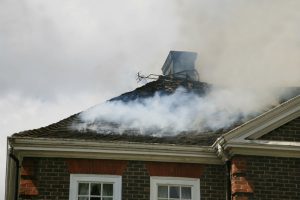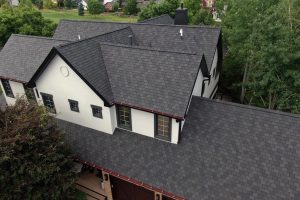
Soffits and fascias are important for protecting your home. Soffits, located under the eaves of your roof, provide ventilation to your attic, while fascias support the bottom row of shingles and gutters, improving the appearance of your home.
It’s crucial to maintain and replace these parts on time. If soffits and fascias are damaged or deteriorating, it can lead to moisture buildup, pest infestations, and structural problems.
Knowing why soffits and fascias are important can help keep your home safe and in good condition for a long time.
Understanding Soffits and Fascias
To understand soffits and fascia, it’s important to know what they are and where they are in your home. Soffits are found underneath the roof’s eaves, covering the space between the roof’s edge and the outside walls. Fascias, on the other hand, are installed along the roofline, supporting the bottom row of tiles or shingles while also serving as a base for attaching gutters.
Types of Fascia Materials
There are several materials that are commonly used for soffits and fascias:
1. Vinyl
Benefits: Minimal maintenance, resistant to rot and water damage, cost-effective.
Drawbacks: Limited color options, can become brittle in extreme cold.
2. Aluminum
Benefits: Durable, lightweight, resistant to rust and corrosion.
Drawbacks: Can dent easily, higher initial cost compared to vinyl.
3. Wood
Benefits: Traditional appearance, can be painted or stained to match home aesthetics.
Drawbacks: Requires regular maintenance to prevent rot and insect damage.
4. Composite
Benefits: Combines durability with aesthetic flexibility, resistant to moisture and pests.
Drawbacks: Higher cost than vinyl and wood, requires professional installation for best results.
Signs That Indicate Replacement or Repair is Needed
Recognizing the signs of soffit replacement and fascia deterioration is essential to protect your home from further damage. Here are some key indicators that it might be time for repair or replacement:
Visual Indicators
- Cracked or Flaking Paint: When the paint on your soffits and fascias starts to crack or peel, it’s a clear sign that these components are no longer protecting your home as they should.
- Warping or Sagging Fascia Boards: Warped or sagging fascia boards are often an indication of underlying structural issues. If you notice this, it might be time for a closer inspection.
Moisture-Related Issues
- Moisture Accumulation: Signs of moisture accumulation around your soffits and fascias can lead to severe problems. This includes water stains, peeling paint, and even wood rot.
- Mold Growth: Mold growth on soffits and fascias not only looks unsightly but also indicates lingering moisture issues that can impact your roof’s structure and attic ventilation.
- Effects on Roof Structure and Attic Ventilation: Prolonged moisture exposure can weaken the roof structure, leading to more extensive repairs. Poor ventilation in the attic can cause condensation, resulting in mold and mildew development.
Pest Infestations
Damaged soffits and fascias provide easy entry points for pests.
Common Pests: Birds, squirrels, rats, and insects often find their way into these compromised areas.
Consequences: Once inside, these pests can cause significant damage by chewing wires, nesting in insulation, and spreading diseases.
Ventilation Problems
Healthy soffits play a crucial role in maintaining attic ventilation. Damaged soffits can lead to:
Poor Airflow Symptoms: Symptoms of poor airflow include increased attic temperatures, higher energy bills, and potential ice dams forming in colder weather.
Regular inspections help catch these warning signs early. Addressing these issues promptly ensures the longevity of your roof and maintains a healthy home environment.
The Costs Involved in Soffit and Fascia Work
Understanding the cost of soffit replacement and cost of soffit installation helps you plan your budget effectively. Here’s a breakdown of costs per linear foot for different materials:
| Material Cost (per linear foot)
Vinyl |
$6-$10 |
| Aluminum | $8-$20 |
| Wood | $15-$30 |
| Composite | $20-$30 |
Labor costs vary based on the material and the complexity of the job. On average, expect to pay:
Soffit installation: $1-$3 per linear foot
Fascia installation: $6-$20 per linear foot
When hiring a contractor for fascia repair, request detailed quotes to compare prices and services. This ensures you get competitive pricing and quality work.
Maintenance Tips to Prolong the Lifespan of Soffits and Fascias
Regular upkeep is crucial for extending the life of your soffits and fascias. Knowing how to maintain soffits and fascias can save you from costly repairs.
Regular Inspection Practices
A thorough inspection every six months helps catch early signs of damage:
Visual Check: Look for cracked or peeling paint, sagging sections, and visible mold.
Probing: Use a screwdriver to gently probe the wood, checking for softness that indicates rot.
Attic Inspection: Ensure proper ventilation and look for signs of moisture or pest intrusions.
Recommended Maintenance Routines
Implementing these routines keeps your soffits and fascias in top condition:
Clean Gutters: Regularly clear out leaves and debris to prevent water overflow that can damage fascia boards.
Repaint or Seal: Every few years, repaint wooden fascia boards or apply a sealant to protect against moisture.
Repair Promptly: Address minor damages immediately to prevent them from escalating.
Consistent care ensures your home’s protective features remain effective, safeguarding your property from potential issues.
Finding Professional Help for Replacement or Repair
When it comes to finding a roofing contractor for repairs, particularly for soffits and fascias, making the right choice can save you time and money. Here are some key considerations:
Key Considerations When Selecting a Roofing Contractor
Experience with Soffit/Fascia Work: Ensure the contractor has specific experience with soffit and fascia installations or repairs. Ask for examples of previous work to gauge their expertise.
Customer Reviews: Check online reviews and testimonials. Websites like Yelp, Google Reviews, and the Better Business Bureau can provide insights into customer satisfaction and contractor reliability.
How to Request Quotes from Multiple Contractors
- Research Local Contractors: Start by researching local contractors who specialize in roofing services. Create a shortlist based on their expertise and customer feedback.
- Compare and Contrast: Review the quotes side by side, considering both price and quality of materials. Don’t hesitate to ask questions if something isn’t clear.
- Check References: Ask each contractor for references from previous clients. Speaking directly with past customers can provide valuable insights into their work ethic and quality.
- Request Detailed Quotes: Contact at least three contractors to request detailed quotes. Ensure each quote includes:
- Cost of materials (vinyl, aluminum, wood)
- Labor costs
- Estimated timeline for the project
Keeping Your Roof In Check With A Roof Inspection
Identifying the right moment to replace soffits and fascias is crucial for maintaining a safe and efficient home. If you ntice any warning signs, don’t hesitate to act with Divided Sky Roofing.
Proactive roof inspections can:
- Prevent costly repairs by addressing minor issues early.
- Ensure proper attic ventilation and structural integrity.
- Protect your home from pests and moisture damage.
Understanding when to replace soffits and fascias keeps your roof in top shape and prolongs its lifespan.
Frequently Asked Questions About Soffits and Fascias
What are soffits and fascias, and why are they important?
Soffits and fascias are essential components of a home’s exterior that help protect the roof and attic from environmental elements. Soffits are located beneath the eaves, while fascias run along the edge of the roof. Timely maintenance and replacement of these components are crucial to prevent moisture damage, pest infestations, and ensure proper ventilation.
What materials are commonly used for soffits and fascias?
Common materials for soffits and fascias include vinyl, aluminum, wood, and composite. Vinyl is low-maintenance and resistant to rot; aluminum is durable and weather-resistant; wood offers a classic look but requires more upkeep; composite materials combine benefits of different substances for enhanced durability.
How can I tell if my soffits or fascias need repair or replacement?
Signs that indicate repair or replacement include cracked or flaking paint, warping or sagging fascia boards, moisture accumulation, mold growth, pest infestations, and poor attic ventilation. Regular inspections can help catch these issues early.
What are the costs involved in replacing soffits and fascias?
The cost of soffit and fascia work varies by material type. On average, vinyl is less expensive than aluminum or wood. Labor costs also contribute to the total expense. It’s advisable to get quotes from multiple contractors to compare pricing.
What maintenance tips can help prolong the lifespan of my soffits and fascias?
Regular inspections for signs of damage are key to maintaining soffits and fascias. Cleaning debris from gutters, ensuring proper drainage, and repainting when necessary can also help extend their lifespan. Establishing a routine maintenance schedule is recommended.
How do I find a professional for soffit and fascia repairs?
When selecting a roofing contractor for soffit and fascia work, consider their experience in this specific area, check customer reviews, and request quotes from multiple contractors to ensure competitive pricing. Personal recommendations can also be valuable.
from: https://mydividedsky.com/is-it-time-to-replace-your-soffits-and-fascias-here-are-the-warning-signs/


No comments:
Post a Comment